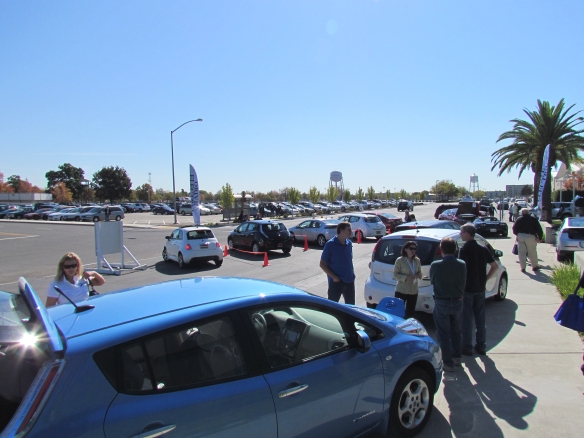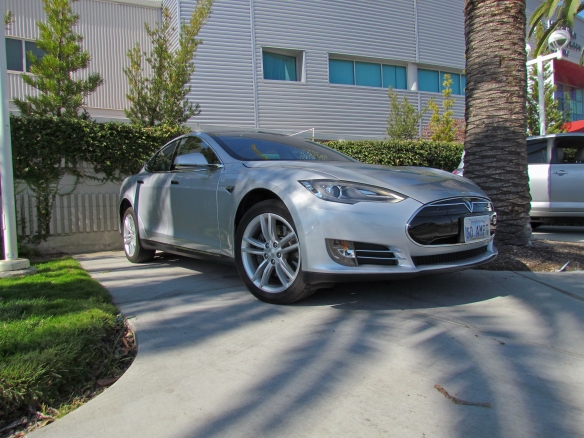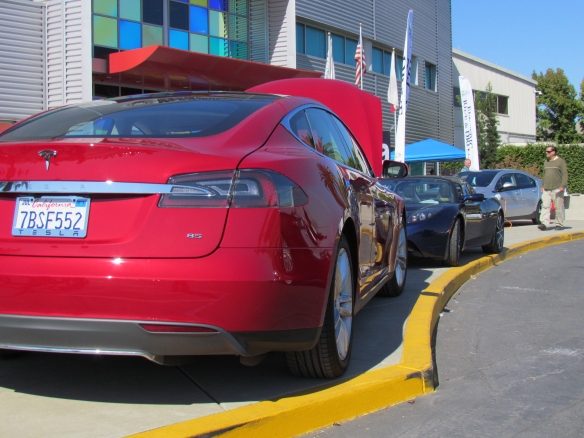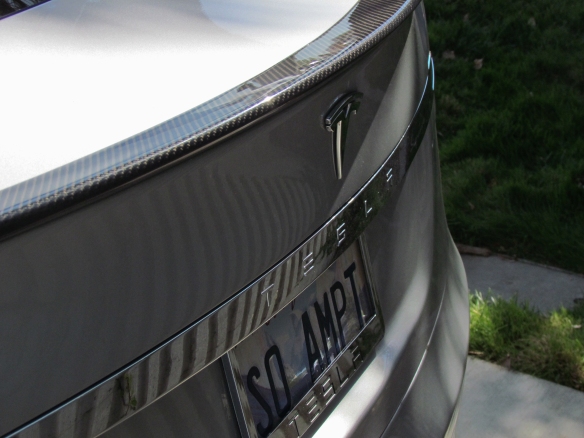
Even while there’s a large amount of money that can be made on car enthusiasts, there will always be a far larger percentage on the consumers that just want some wheels and seats beneath them. Some of those consumers—quite possibly a smaller group than car enthusiasts—may even surpass an internal combustion engine to do so.
The benefits of going electric are debatable, since many attest that the electricity that recharges these cars isn’t always as clean as activists might believe. Likewise the materials used for the batteries (and the hazards that lie within them) are also up for argument. To me, if someone wants an electric car and has solar panels on their roof that they themselves paid for, rock on. I dig wind power myself, or even a nifty hydraulic float that generates power from ocean waves. Even going more ancient and using water wheels would be an interesting technique. The reality is, though, that a lot of power still comes from coal, nuclear, or hydroelectric means which have some form of environmental impact.
With energy production techniques put aside, the next hurdle is cost for electric cars. Unlike in the past, the car-buying public has a fairly open market for body styles, prices, and luxury levels. The vehicles I drove were usually based off an existing vehicle, but produced by that manufacturer, and two of them were actually hybrids with a gasoline engine as emergency backup. What’s nice about such a breadth of vehicles is there is now competition, and trickle-down technology to lower co st.
st.
For the sake of seeing what that group of greenies has offered to them, I took an opportunity presented to drive them for about a mile with each car around McClellan Park, an airfield just north of Sacramento California. Vehicles present were the Ford Fusion Energi and Focus Electric, Chevrolet Volt, Fiat 500e, Nissan Leaf, Tesla Roadster and Model S (both for viewing only), Mitsubishi MiEV (also not for driving), and Toyota Rav4 Electric.

The first vehicle I drove was the Fiat 500e. Already liking the cheeky character of the little Italian 500, I had plenty to talk about with Fiat representative Daniel Martinez (note: business cards are always good to have). Telling Martinez this was my first time in the 500, he informed me that the cars usually have more space to them, especially for rear seat foot room. However, with the battery packs being placed slightly more toward the rear of the vehicle floor to maintain a proper balance of the 500e, it cut into that space. As I’d always read in Fiat 500 reviews, seating was upright and tall just like my own Toyota Echo. Regardless, lean was well controlled at the tame city speeds that inhibited the drive. Probably my least favorite aspects of the 500e were the controls for the seat being toward the center console, and the orange cloth-mesh in the steering wheel rim, which seems likely to chafe ones thumbs if it weren’t for the cars short 90 mile range. The cost is $31,000 ($17,000 with incentives) with no acceleration losses to its non-turbo siblings. The 500e is a California limited model.

My second drive was in a much sleeker package—the Ford Fusion Energi. The Fusion Energi is a very unassuming package, and probably my favorite drive of the day because of that. I say it’s unassuming because the Fusion already comes in a regular hybrid form, making the little green badges blend yet easier into the landscape. The chief exterior sign that you’re looking at a Fusion Energi (aside from actually reading it) is the plug-in door on the left front fender—a door which reminds me of a Koenigsegg supercar’s doors on a miniature scale.
Both the Ford Fusion Hybrid and Fusion Energi have a gasoline four cylinder on board, but the Energi uses it as a backup when the batteries are depleted similar to the Chevy Volt, while the hybrid uses gas and electric jointly like any other hybrid. What I don’t like about the Fusion is the battery placement in the trunk, combined with 60/40 folding rear seat. Since the battery pack takes so much space out of the trunk (reminiscent of Ford’s now extinct Panther platform), I found the roughly 8”x36” gap of useable pass-through space for the folding seat laughably pointless. Regardless, the base price of $38,000 doesn’t seem unreasonable.

Stepping back from these newer entries, the elusive joint effort of Toyota and Tesla (the Rav4 Electric) was present, while the Prius Plug-In strangely wasn’t. Regardless, the similarly bearded representative from Auburn Toyota (of whom I didn’t catch the name or card) and I had a nice discussion about the merits of this old Rav4’s sales and potential. He said 2,500 were to be initially built at the NUMMI plant only two hours away, making it quite a rare prospect to see on the road. One of my first inquiries was about whether the switch to a new Rav4 would decrease the amount of sales for the Rav4 Electric, which he doubts would be a problem. I also asked if the lack of a third row might have decreased interest, which the rep discounted that not many people seemed to mind. The lack of all-wheel drive, however, has been a problem for him, stating a man in the Lake Tahoe region bailed on the electric version because of needing a snow worthy vehicle, buying a regular Rav4 instead. The rep then opened the rear cargo door and showed me all the space where extra batteries and an electric motor could easily be placed to make such a vehicle. My thoughts then came to the Mercedes AMG SLS Electric, and its use of individual motors at each corner of the car. Perhaps a more versatile AWD system could be Toyota’s next move? Especially since Tesla shall soon sell an AWD Model X, we’ll wait and see. My driving impressions of the Rav was that it shows its age, with a touchier brake/regeneration mode, and of course an old platform and basic, bland interior.


Following the Teslota Rav4, I poked a tadpoles’ nose—the front plug door of the Nissan Leaf was open, and I closed it. Already somewhat familiar with the Leaf from an Earth Day gathering at school some time ago, I knew it had a somewhat tall rear floor when seated in back for the under-floor batteries. One of the Nissan reps that were there, Ron Shaw of Future Nissan in Folsom, asked me if I knew why the front lamps stuck out the way they did. Of course I already knew that it channeled air away from the mirrors to reduce drag (the Nissan GT-R uses similar sculpting for directing air over the rear spoiler). Regardless of that technique, I was given the rather unimpressive drag coefficient of .29—something my Toyota Echo matches, and a Lexus LS600h surpasses at .25cd. To the Leaf’s credit, it’s actually a non-issue .28cd. Still, the Leaf was a familiar and practical package, though the three-star frontal crash rating for the front passenger (at least according to the sticker) was brow-raising.


Like the Nissan Leaf, I’ve already examined the Chevrolet Volt at the Earth Day event, so I knew about the 1.4L engine sitting up front, and the rear seat that’d have my head near the headliner/rear hatch. The Volt rep was actually a Volt owner (though the Rav4 guy would love to own the fleet vehicle he was showing). Unlike the others, the Volt rep gave me a quick go-around of the vehicle, showing the different modes and screens of the car, and took me a few hundred feet to show the difference of “Drive” and “L”—mainly, “L” increases the braking properties when letting off the throttle, meaning more regeneration to the batteries. He did all of this because he knows that people my age don’t tend to know (or care) about cars like they once did. He brought up how at his last event, someone who actually helped develop GM’s old EV1 all-electric car came and chatted him up about the Volt. Before he could start telling me about the EV1, I showed that I was already versed in such matters, noting the Volt using a the similar technique of a T-shaped battery pack that runs through the center of the car, and topping out in the rear. Then I explained that not all us young guys have left cars to touch-screen tablets and $300 headphones, but that I’m still old-fashioned enough to want a more visceral machine than those at the event. The Volt could prove entertaining with the right tweaks, though, especially mid-corner lift-off in “L” mode… that is if it wasn’t so inhibited by safety nannies.
Finally I hopped back into the Focus Electric, probably one of the less driven by those around me. The same none-to-chatty Ford rep from the Fusion my host yet again, and he was wondering who I was published with. Ah the feeling of explaining disappointing nature of Northern California publications when it comes to young automotive media people—there’s not a whole lot of market for us. The conversation made the Focus drive somewhat forgettable aside from having possibly the laziest regen feeling of the bunch. For the $35,000 price tag of the Focus Electric, I’d definitely shoot for the Fusion Energi instead.
Looking outside the test vehicles and instead at those displayed, the Tesla Model S is an amazing car to behold. It’s a smooth and subtle machine that seems far more popular than the other models staged that day. A visit to any well-populated area can make for a dozen sightings a day. Where the Tesla Model S went right isn’t just the sales tactics, but the packaging of multiple power outputs. Yes it costs more, but lets not forget how the Model S is a supreme balance of luxury, sport, safety, and practicality with its two trunks a la Porsche Cayman makes for a compelling buy. The late crash-turned-fire as of late seems to be made to be worse than it should be. After all, how many cars from marques like Ferrari, Lamborghini, and even celebrity Dick Van Dyke’s Jaguar XJ become blazed for far less reasonable conditions? In my eyes, the Tesla Model S might be the Bugatti Veyron of electric cars for a while.



